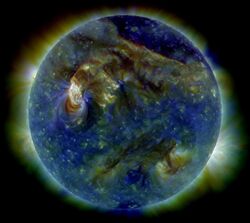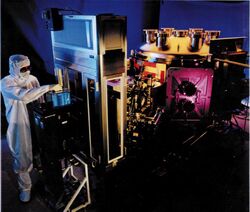الأشعة فوق البنفسجية القصوى


أشعة فوق بنفسجية قصوى (بالإنگليزية: Extreme ultraviolet، اختصاراً EUV أو XUV)، أو إشعاع فوق بنفسجي عالي الطاقة، هو إشعاع كهرومغناطيسي، يشغل المجال من الطيف الكهرومغناطيسي و الذي تتراوح أطوال موجاته ما بين 10 نانومتر nm و حتى 124 نانومتر nm، و بذلك (و وفقاً لمعادلة بلانك آينشتاين) ففيه فوتونات بكميات طاقية تتراوح ما بين 124 إلكترون-فولت eV و حتى 10 إلكترون-فولت eV (بما يتوافق مع أطوال الموجات 10 نانومتر nm و حتى 124 نانومتر nm على الترتيب). تتولّد الأشعة فوق البنفسجية القصوى في الطبيعة بواسطة إكليل الشمس و اصطناعياً من خلال البلازما، مصادر توليد التوافقيات العالية و مصادر الضوء السنكروتروني. و حيث أن مجال الأشعة الفوق البنفسجية يمتد ليصل إلى 100 نانومتر nm فهناك بعض التراكب في المصطلحات.
الاستخدامات الرئيسية للأشعة الفوق البنفسجية القصوى هي: التحليل الطيفي للانبعاث الضوئي، التصوير الشمسي و النقش الضوئي. تعتبر الأشعة الفوق البنفسجية القصوى أكثر مكونات الطيف الكهرومغناطيسي التي يتم امتصاصها في وسط الهواء. و تتطلب خلاءً شبه تام للانتقال من نقطة إلى أخرى في الفراغ.
. . . . . . . . . . . . . . . . . . . . . . . . . . . . . . . . . . . . . . . . . . . . . . . . . . . . . . . . . . . . . . . . . . . . . . . . . . . . . . . . . . . . . . . . . . . . . . . . . . . . . . . . . . . . . . . . . . . . . . . . . . . . . . . . . . . . . . . . . . . . . . . . . . . . . . . . . . . . . . . . . . . . . . . .
توليد الأشعة الفوق البنفسجية القصوى
الذرات المتعادلة الشحنة (المحايدة كهربائياً) أو المادة المكثفة لا يمكنها توليد إشعاع فوق بنفسجي أقصى. إنما يتوجب أن يحدث التأيين أولاً. يمكن أن يستصدر الضوء الفوق بنفسجي الأقصى فقط من الإلكترونات المرتبطة بالأيونات الموجبة متعددة الشحنة؛ فعلى سبيل المثال، تبلغ الطاقة المطلوبة لانتزاع الكترون من أيون ذرة الكربون ذات الشحنة +3 ( ثلاثة إلكترونات انتُزعت مسبقاً) نحو 65 الكترون-فولت eV. مثلُ هذه الإلكترونات تكون مرتبطة ارتباطاً وثيقاً أكثر من إلكترونات التكافؤ. إن وجود الأيونات الموجبة متعددة الشحنات ممكنٌ فقط في البلازما الكثيفة الحارّة. و من جهة أخرى، يمكن توليد الإلكترونات الحرة و الأيونات مؤقتاً و لحظياً عند تعرضها لحقل كهربائي شديد ناجم عن توافقيات عالية جداً لحزمة ليزر. تتسارع الإلكترونات خلال عودتها إلى الأيون الأصل، محررةً فوتونات ذات طاقات أعلى و بشدات متناقصة، و التي يمكن أن تكون ضمن المجال الفوق البنفسجي الأقصى. إذا شكّلت الفوتونات المُحرّرة إشعاعات مؤينة، فسوف تؤين أيضاً ذرات الوسط المولد للتوافقيات، مُستنزفةً بذلك مصادر توليد التوافقيات الأعلى. تهرب الإلكترونات المُحرّرة لأن الحقل الكهربائي للضوء الفوق البنفسجي الأقصى ليس شديدأً كفايةً ليسوق الإلكترونات إلى توافقيات أعلى، في هذه الأثناء لا تعود الأيونات الأصل سهلة التأين كحال الذرات المحايدة الشحنة الأصلية. و لذلك، فتتنافس عمليتي توليد الضوء الفوق البنفسجي الأقصى و امتصاصه (التأين) بقوة فيما بينهما.
بكل الأحوال، في عام 2011 رصد شامبهو غيمير Shambhu Ghimire و آخرون توليد التوافقيات العالية في بلورات كبيرة الحجم من مركب أكسيد الزنك ZnO. اجتذب الأمر الاهتمام في استثمار تقصي إمكانية و آلية توليد التوافقيات العالية في الحالة الصلبة للمادة. يمكن انبعاث الإشعاع الفوق البنفسجي الأقصى في ثاني أوكسيد السيليكون SiO2 أو الياقوت.
التوليد المباشر القابل للتوليف للأشعة الفوق بنفسجية القصوى
يمكن توليد الضوء الفوق بنفسجي الأقصى من قبل الإلكترونات الحرة التي تدور في المعجل التزامني
يمكن توليد ضوء فوق بنفسجي أقصى ضيق الحزمة قابل للتوليف باستمرار عن طريق مزج الأمواج الرباعي في خلايا غاز الكريبتون و الهيدروجين إلى أمواج منخفضة الطول حتى 110 نانومتر nm . في الحجرات الغازية عديمة النوافذ شُوهد مزج الأمواج الرباعي الثابت منخفضاً حتى 75 نانومتر nm.
امتصاص الإشعاع الفوق بنفسجي الأقصى في المادة
حين يتم امتصاص فوتون إشعاع فوق بنفسجي أقصىEUV، يتم توليد الإلكترونات الثانوية و إلكترونات التأثير الكهروضوئي من خلال التأيين، بشكل يشبه إلى حد كبير ما يحدث حيث يتم امتصاص الأشعة السينية أو حزم الإلكترونات من قبل المادة.[1]
إن استجابة المادة للإشعاع الفوق بنفسجي الأقصى يمكن إظهاره في المعادلات التالية: نقطة الامتصاص: EUV طاقة فوتون = 92 إلكترون-فولت eV = طاقة ارتباط الإلكترون + الطاقة الابتدائية الحركية لإلكترون التأثير الكهروضوئي؛ ضمن 3 مسارات حرة وسطية لإلكترون التأثير الكهروضوئي (1-2 نانومتر nm): فإ، انخفاض الطاقة الحركية لإلكترون التأثير الكهروضوئي يكون = كمون التأين + الطاقة الحركية للإلكترون الثانوي؛ ضمن 3 مسارات حرة وسطية للإلكترون الثانوي ( حوالي ~ 30 نانومتر nm) فإن انخفاض الطاقة الحركية للإلكترون الثانوي = كمون التأين + .
Strictly speaking, photoelectrons, Auger electrons and secondary electrons are all accompanied by positively charged holes (ions which can be neutralized by pulling electrons from nearby molecules) in order to preserve charge neutrality. An electron-hole pair is often referred to as an exciton. For highly energetic electrons, the electron-hole separation can be quite large and the binding energy is correspondingly low, but at lower energy, the electron and hole can be closer to each other. The exciton itself diffuses quite a large distance (>10 nm).[2] As the name implies, an exciton is an excited state; only when it disappears as the electron and hole recombine, can stable chemical reaction products form.
Since the photon absorption depth exceeds the electron escape depth, as the released electrons eventually slow down, they dissipate their energy ultimately as heat. EUV wavelengths are absorbed much more strongly than longer wavelengths, since their corresponding photon energies exceed the bandgaps of all materials. Consequently, their heating efficiency is significantly higher, and has been marked by lower thermal ablation thresholds in dielectric materials.[3]
Solar minima/maxima
Certain wavelengths of EUV vary by as much as 2 orders of magnitude[4][المصدر لا يؤكد ذلك] between solar minima and maxima, and therefore may contribute to climatic changes, notably the cooling of the atmosphere during solar minimum.
EUV damage
Like other forms of ionizing radiation, EUV and electrons released directly or indirectly by the EUV radiation are a likely source of device damage. Damage may result from oxide desorption[5] or trapped charge following ionization.[6] Damage may also occur through indefinite positive charging by the Malter effect. If free electrons cannot return to neutralize the net positive charge, positive ion desorption[7] is the only way to restore neutrality. However, desorption essentially means the surface is degraded during exposure, and furthermore, the desorbed atoms contaminate any exposed optics. EUV damage has already been documented in the CCD radiation aging of the Extreme UV Imaging Telescope (EIT).[8]
Radiation damage is a well-known issue that has been studied in the process of plasma processing damage. A recent study at the University of Wisconsin Synchrotron indicated that wavelengths below 200 nm are capable of measurable surface charging.[9] EUV radiation showed positive charging centimeters beyond the borders of exposure while VUV (Vacuum Ultraviolet) radiation showed positive charging within the borders of exposure.
Studies using EUV femtosecond pulses at the Free Electron Laser in Hamburg (FLASH) indicated thermal melting-induced damage thresholds below 100 mJ/cm2.[10]
An earlier study[11] showed that electrons produced by the 'soft' ionizing radiation could still penetrate ~100 nm below the surface, resulting in heating.
انظر أيضاً
- Extreme Ultraviolet Explorer
- Extreme Ultraviolet Variability Experiment
- Extreme ultraviolet Imaging Telescope
- High harmonic generation
- CHIPSat
- ليثوغرافيا فوق بنفسجية قصوى
- قائمة مقالات فيزياء الپلازما
المصادر
- ^ Henke, Burton L.; Smith, Jerel A.; Attwood, David T. (1977). "0.1–10‐keV x‐ray‐induced electron emissions from solids—Models and secondary electron measurements". Journal of Applied Physics. AIP Publishing. 48 (5): 1852–1866. Bibcode:1977JAP....48.1852H. doi:10.1063/1.323938. ISSN 0021-8979.
- ^ Bröms, Per; Johansson, Nicklas; Gymer, Richard W.; Graham, Stephen C.; Friend, Richard H.; Salaneck, William R. (1999). "Low Energy Electron Degradation of Poly(p-phenylenevinylene)". Advanced Materials. Wiley. 11 (10): 826–832. doi:10.1002/(sici)1521-4095(199907)11:10<826::aid-adma826>3.0.co;2-n. ISSN 0935-9648.
- ^ A. Ritucci et al., "Damage and ablation of large band gap dielectrics induced by a 46.9 nm laser beam", March 9, 2006 report UCRL-JRNL-219656 Archived يناير 25, 2017 at the Wayback Machine (Lawrence Livermore National Laboratory).
- ^ Moan, Johan; Juzeniene, Asta (2010). "Solar radiation and human health". Journal of Photochemistry and Photobiology B: Biology. Elsevier BV. 101 (2): 109–110. doi:10.1016/j.jphotobiol.2010.08.004. ISSN 1011-1344.
- ^ Ercolani, D.; Lazzarino, M.; Mori, G.; Ressel, B.; Sorba, L.; Locatelli, A.; Cherifi, S.; Ballestrazzi, A.; Heun, S. (2005). "GaAs Oxide Desorption under Extreme Ultraviolet Photon Flux". Advanced Functional Materials. Wiley. 15 (4): 587–592. doi:10.1002/adfm.200400033. ISSN 1616-301X.
- ^ DiMaria, D. J.; Cartier, E.; Arnold, D. (1993). "Impact ionization, trap creation, degradation, and breakdown in silicon dioxide films on silicon". Journal of Applied Physics. AIP Publishing. 73 (7): 3367–3384. doi:10.1063/1.352936. ISSN 0021-8979.
- ^ Akazawa, Housei (1998). "Soft x-ray-stimulated positive ion desorption from amorphous SiO2 surfaces". Journal of Vacuum Science & Technology A: Vacuum, Surfaces, and Films. American Vacuum Society. 16 (6): 3455–3459. doi:10.1116/1.581502. ISSN 0734-2101.
- ^ Defise, Jean-Marc (1997-10-15). "In-orbit diagnostic of the EIT EUV CCD radiationinduced aging" in Optical Science, Engineering and Instrumentation. 3114: 598–607, SPIE. doi:10.1117/12.278903.
- ^ J. L. Shohet, http://pptl.engr.wisc.edu/Nuggets%20v9a.ppt Archived 2006-08-29 at the Wayback Machine
- ^ R. Sobierajski et al., http://hasyweb.desy.de/science/annual_reports/2006_report/part1/contrib/40/17630.pdf
- ^ "FEL 2004 – VUV pulse interactions with solids" (PDF).

